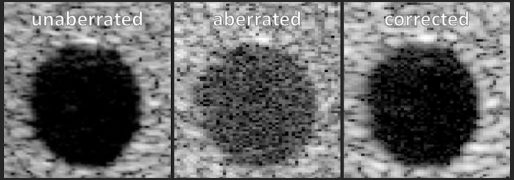
Hanna Bendjador wins the Best Student Award at IEEE IUS, Las Vegas, 2020
Our PhD student, Hanna Bendjador, has won the Best Student Award in the category Medical Ultrasonics at the IEEE International Ultrasonics Symposium, which was held virtually in early September 2020. She brings to eight the number of students from our group who have received this award in the past decade. Hanna Bendjador presented a study entitled “SVD beamforming for ultrafast aberration correction and real-time speed-of-sound quantification”.
Medical ultrasound images are reconstructed from ultrasound waves traveling back and forth in the body. Some biological tissues, e.g. bones and fat layers, affect the propagation of ultrasound waves because of their complex structure, and therefore alter the image quality and accuracy. These alterations are called aberrations. Under the supervision of Thomas Deffieux and Mickael Tanter, Hanna Bendjador develops advanced methods for assessing and correcting these aberrations in real-time. She demonstrates two major biomedical applications:
- in the field of neuroimaging, aberration correction improves the quality of transcranial mouse brain imaging
- in the field of hepatology, she develops a method for mapping the fat fraction in the liver, providing a score for quantifying non-invasively the degree of steatosis
In ultrafast ultrasound, images are reconstructed the emission of several ultrasound waves tilted at different angles. The aberration correction method relies on optimizing the “angular coherence matrix” of the image, which expresses the coherence between the echoes resulting from the different tilted emisssions.
Compared to other research approaches in this research field hampered by long computation times, a major impact of this concept of SVD beamformer based on matrix operations is the ability to estimate and correct aberrations in real time several times per second.

References:
Bendjador H, Deffieux T, Tanter M. The SVD Beamformer: Physical Principles and Application to Ultrafast Adaptive Ultrasound. IEEE Transactions on Medical Imaging 2020:1–1. https://doi.org/10.1109/TMI.2020.2986830.





